Spotlight on Josh Trujillo
Jan 29, 2012
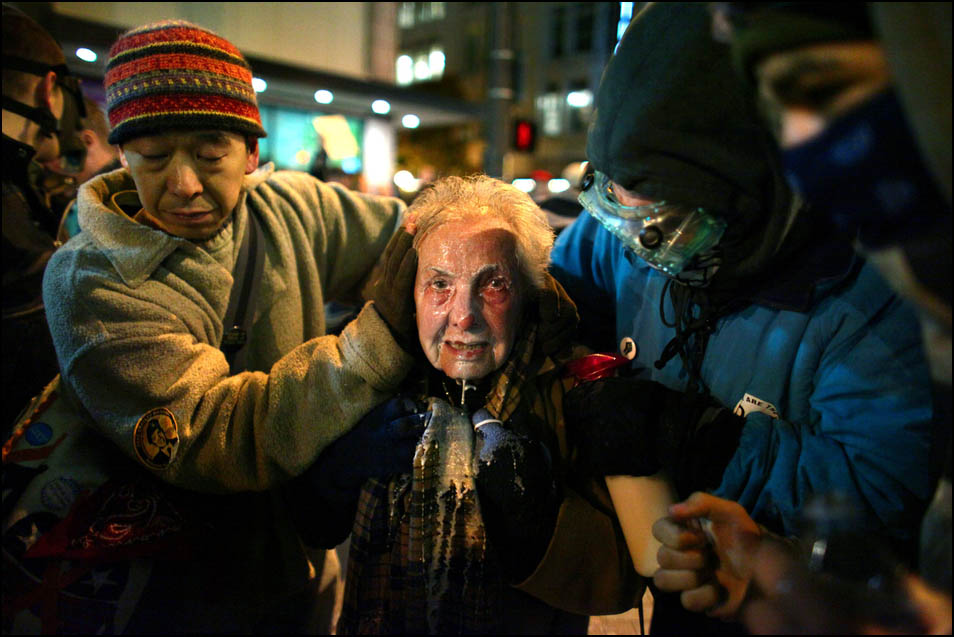
TID:
Josh, thanks for taking part in the interview. Please tell us a little bit about yourself, and how you came across this situation.
JOSH:
First, thanks for the invitation to participate in TID. The site is a valuable window into the thought process and technique of some amazing photography. To be included here is an honor.
I regularly use Twitter for news tips. I have embraced the social tool, not just as a way to promote work, but also a way to keep up with news as it happens. As a one-man photo operation, I rely on all available tools to monitor our metro area, and Twitter is probably my main source. I have built up a modest following who now regularly send me tips via the social network. Many of them assist me and seem to enjoy participating in the news gathering process.
The Occupy protests were regularly making news here in Seattle. I set up a few advanced Twitter searches to monitor for keywords related to the local movement.
While covering another story that evening, I saw quite a bit of buzz about an Occupy protest marching in downtown Seattle disrupting traffic during rush hour. The Occupy protests had been happening in Seattle for about two months, so at that point it was a regular occurrence. I looked at the geotag info on some of the recent tweets from the protest and was able to find their location.
TID:
Please talk about your thoughts leading up to the moment captured in your photograph.
JOSH:
Usually when I arrive at a tense scene I take a moment to create some situational awareness. After all, I have no desire to be arrested or injured. I have a wonderful family to go home to at night.
However that night, the events unfolded so quickly that I found myself marching into the middle of the confrontation. Within moments of my arrival, Seattle police officers released what the subject of the photo later described as a “fountain of pepper spray.” And I happened to be standing right next to officers using the fire extinguisher-like canisters.
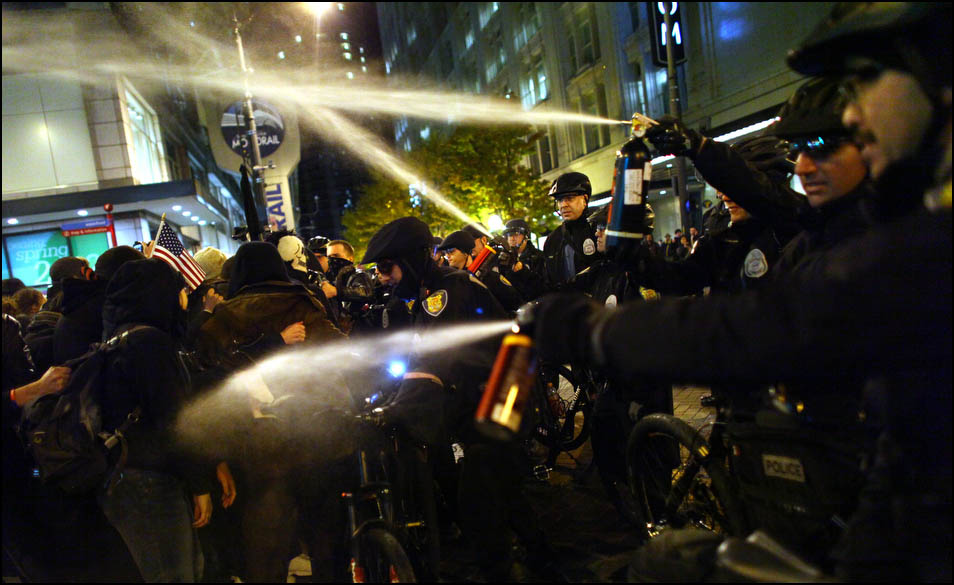
Police had repeatedly warned the demonstrators to clear the intersection as they were blocking traffic during rush hour. The police had monitored the march, but their patience for the protesters waned when they refused to move from the intersection. Traffic was backed up and motorists were equally frustrated.
I bobbed and weaved, trying to avoid being hit with the chemical irritant as it rained down on the protesters. Some of the spray hit me, but my camera mostly protected my face. I retreated to the sidewalk where officers were ordering people to go. But while on the sidewalk, more pepper spray was released onto those no longer blocking traffic. The officers were desperately trying to clear what now was an agitated crowd.
Somewhere in that upset (and now retreating) mass of people was 84 year-old Dorli Rainey.
TID:
As the situation was unfolding, what were you were thinking as you made the image?
JOSH:
I am from a culture where elders are respected. So when I saw a woman who looked older than my own grandmother, yelling and choking from the pepper spray, my heart skipped a beat. I quickly gathered myself and walked toward her to document the aftermath.
At that moment, the protesters were not thrilled that I was there. I was being yelled at, told to “get out of here,” and shoved. Ms. Rainey, who was choking from the effects of the spray, actually mustered up enough energy to swear at another reporter who was asking if she was okay. Ms. Rainey was a mess. She was coughing and having trouble opening her eyes. She had a milky solution splashed in her face and was now agitated, along with the rest of the crowd.
Reading body language is important in situations like these. But in this case, words were also exchanged suggesting I was not welcome there. There was quite a bit a swearing and some shoving from the people escorting her away. The scene moved fast and emotions were high as people coughed and struggled to breathe. But as I see it, the potential news value and uniqueness of the situation overrode the subjects' desires at that moment.
I keep a list in my head when making photos in sensitive situations, especially ones where I am not sure I am welcome. News value is at the top of that list. The unique nature of a scene is probably the second element I consider. Coming in third place is compassion for a subject. I always try to work with compassion. A subject's desire to control the situation, and in effect control me, is much farther down the list. So that never really factored into my decision-making that night. I knew I had something unique, but I didn't realize how the image would later explode.
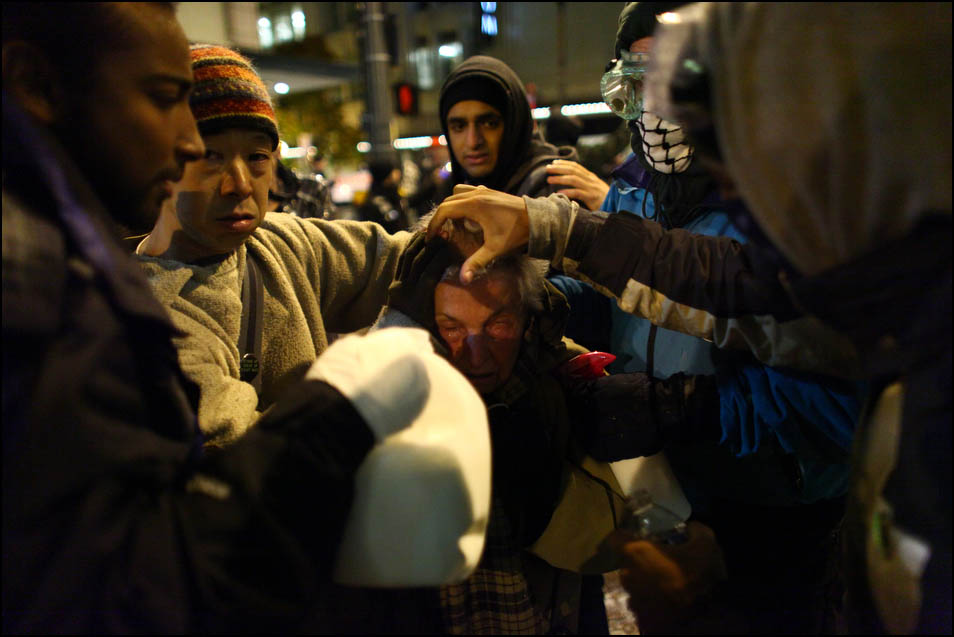
TID:
Were there any points of conflict during the making of this picture or during the story, and if so, how did you manage it?
JOSH:
I have my phone set to beep every time someone tweets and includes my username in their message.
Minutes after filing and publishing the photograph of Dorli Rainey, I tweeted the link to the image on the Seattle P-I. Then my phone beeped. Then it beeped again. And again and again. Each beep of my phone signaled another person "re-tweeting" the image. Within about five minutes I had to change the settings on my phone because it was not stopping. Soon, some of Twitter's top users — including Hollywood and media stars — were tweeting about the image. It was quickly "going viral."
Working at an online operation, with the ability (and great responsibility) to publish my own work, I will often quickly file a photo (the online audience wants their news now) and later sit down for another look at my take, making sure I picked the best frame and have the best caption. Many times I will substitute an image or perfect a caption. So my goal this night was to get the image out fast and hopefully return for a second edit.
When I took a second look at my take from the protest, I was not sure I had sent the best image. After all, photojournalists are trained not to have subjects glaring right into the camera. It becomes distracting and can subtly make the viewer aware of the photographer. I train interns to understand this, and I talk about it when I teach photo classes. Just like when I see my shadow or my reflection in a photo, images with eye contact are usually ignored in the first edit. I want viewers to feel as if they are there in the scene. I don't want them to be aware of my presence. But with this image I had just broken my own rule, one that in my mind now made the picture into more of a portrait.
I contemplated returning to our publishing tool to sub-out the image for another frame — one where she was not looking at me or where her eyes were closed— but I stopped. Something about that image was connecting with viewers. Twitter user @Alyssa_Milano, an actress with nearly 2 million followers, tweeted about how looking at that woman shocked her. It was as if the subject was looking right back at people and connecting in a way that my training as a photojournalist preached against. So I left it alone.
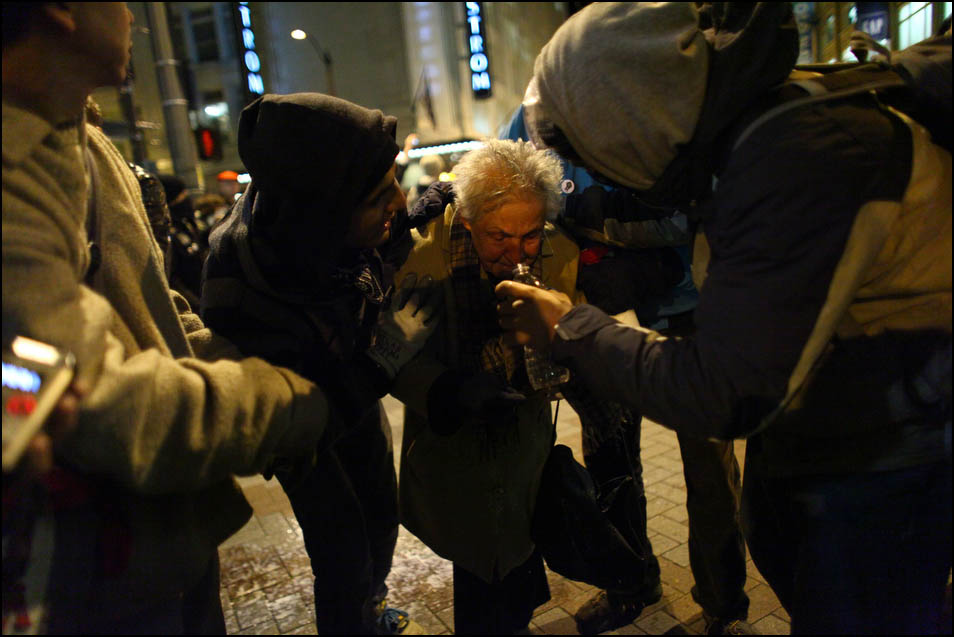
When I woke up the next morning, my Facebook page was full of links and comments about the photo. One link led to a post by a Washington Post arts critic that said, “Rainey’s direct gaze at the camera as her face drips with pepper spray and milk is a haunting, cinematic image of brutality, emphasized even more by the chiaroscuro of dark gloved hands holding her head up to lead her to safety.”
Another writer at The Atlantic said the image may be the “defining image” of the Occupy movement; and the art critic for The Guardian in the U.K. said it was "an image straight out of a Christian Renaissance painting." Suddenly Ms. Rainey was a guest on national talk shows and the image was featured on The Colbert Report, with the host poking fun at the Seattle Police Department’s response to the use of pepper spray on an 84 year-old woman.
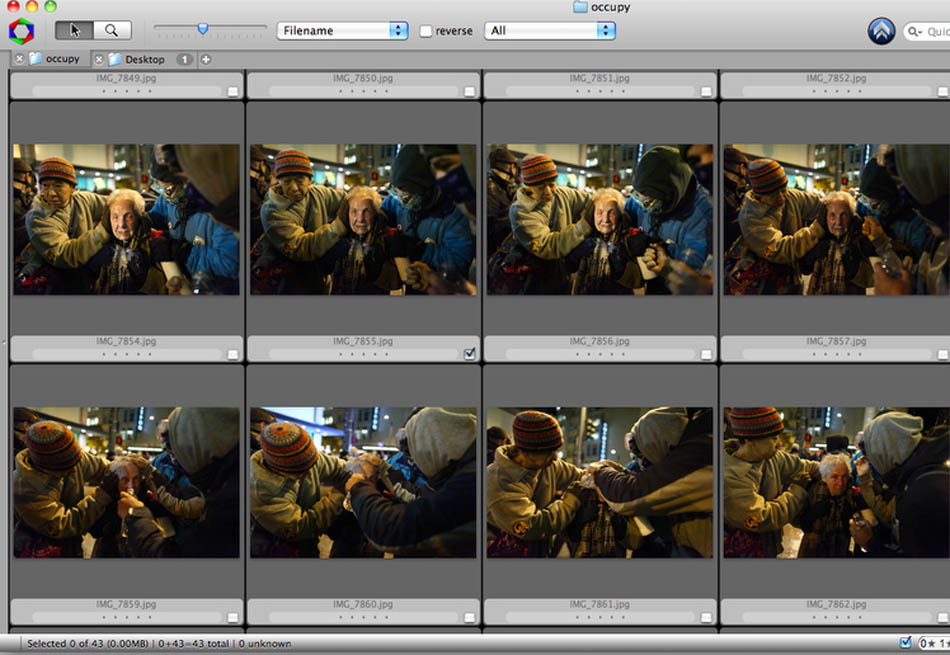
After 12 years in this profession at 6 newspapers, and after covering assignments that ranged from the war in Afghanistan to the Super Bowl, I never had an image spark so many words and so much debate. The Seattle mayor called Ms. Rainey to apologize, police leaders announced policy changes because of the incident, an investigation was launched and talk show hosts, as well as callers, both bashed and praised the 84 year-old.
I was invited on talk shows and asked to talk about the image and the situation but declined all invitations. I thought the image should just speak for itself.

TID:
After the image was taken were there any lessons that you came away with?
JOSH:
As the image spread online, I watched as dozens of websites used the photo without permission. The following night, during a protest where members of the Occupy movement teamed up with union members to take over a local bridge, the image appeared on pamphlets and on a T-shirt. I attempted to send out a few DMCA (Digital Millennium Copyright Act) notices to websites but quickly gave up as it would have consumed all my time. I turned that over to lawyers in New York.
The image became popular as the Occupy protests veered from demonstrations against Wall Street and the financial system to conflicts with police in cities across the U.S.
TID:
What advice do you have to gain access to these situations?
JOSH:
Protests and conflict can be difficult to cover. Police are usually not thrilled that you are there, and protesters, especially the anarchist crowd, are often not friendly to the media. The groups are media savvy. Police know that an image of them acting to control a crowd can portray them in an unfavorable light. Protesters, anarchists in particular, know that a photo of their face can later be used against them if they decide to smash windows and create other mayhem. There's a delicate balance that needs to be found where you can honestly document what is happening without becoming emotionally invested in either side's actions. Maintaining your safety is also paramount.
Ultimately, you just have to pay attention to your surroundings and your subjects and stay alert. Pay attention to the details. In a situation that has potential to erupt in chaos or violence, I almost always try to have a plan to get out of the way if it goes too far.
I also rely heavily on non-verbal communication. I am a believer that photojournalists are masters of non-verbal communication. We have to notice those small visual cues that hint as to what is coming next. When pepper spray is involved, try to notice when officers start shaking the cans like spray paint. That is a cue that you should probably adjust your position so you don't get hit with the spray.

TID:
Have you talked to her since the picture ran?
JOSH:
Since the incident I have talked with Rainey. I was introduced to her two days later, during a press conference in front of the Seattle Police Department. Occupy protesters and officials from SPD's Department of Professional Accountability addressed each other with statements and held a press conference. The event was intended to show the City's effort to address complaints of abuse of force and gave protesters a chance to address officials from the police department.
Rainey has since told me that her "lung capacity is still below normal" and blames it on the pepper spray incident. She has become somewhat of a local celebrity.
An interview with Rainey was published two months after the incident in theJanuary 13th edition of the U.K. Guardian. In the story she said the incident has changed her life. She said the day after she was pepper sprayed her phone started ringing and it still hasn't stopped. "Now I don't get to clean my house, or do grocery shopping, or get a haircut because my calendar is just full. I sit in my bedroom with a computer that goes day and night. It is a life change. And I did not ask for it. I've never been a publicity hound. I'm not complaining, but it's difficult."
++++
BIO:
Joshua Trujillo is a visual journalist at seattlepi.com, the first major metro daily newspaper to go online-only. He worked at the Seattle Post-Intelligencer newspaper from 2003 until the presses stopped in 2009. Since the closure of the paper, his job has been redefined in dramatic ways. Trujillo embraces use of social media, uses an assortment of online tools to convey information to readers, often writes and reports stories, and even broke news of a major local economic story in 2009.
Trujillo is a visual storyteller with a passion for traditional photojournalism, but if a story can be told more effectively or immediately via another method he is not shy about trying it. Prior to working at the P-I, he was in the Hearst Fellowship Program where he worked at the Houston Chronicle, the San Antonio Express-News, and the P-I. He also did a tour for Hearst Newspapers covering the war in Afghanistan in 2001.
Click here to follow Joshua on Twitter:
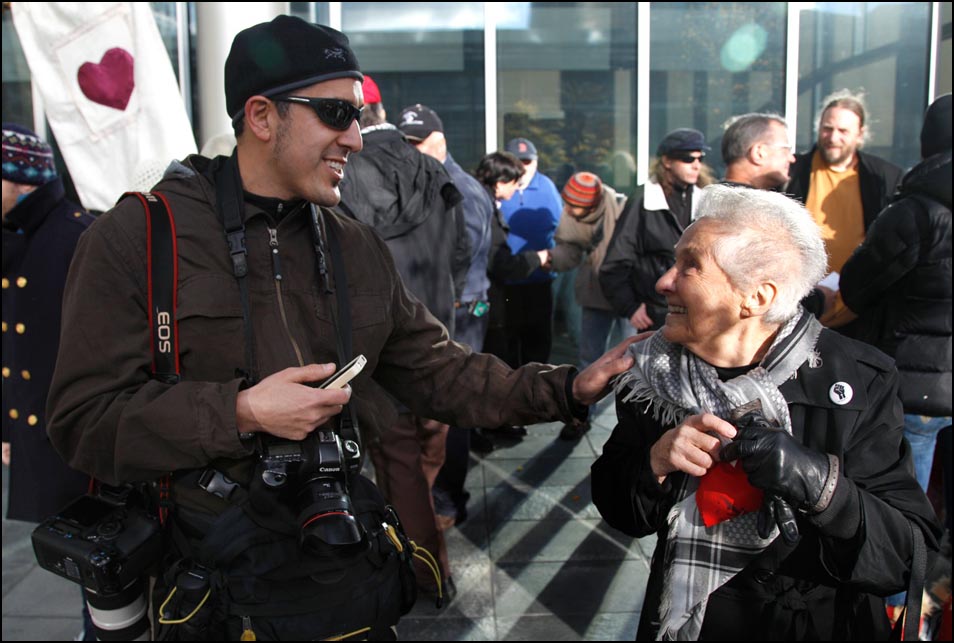
Josh Trujillo is introduced to Dorli Rainey after a press conference on the steps of the Seattle Police Department. Photo by Ted S. Warren, Associated Press
TID NOTE:

+++
Next week we'll deconstruct how Maggie Steber photographed the abstract theme of memory while on assignment for National Geographic.
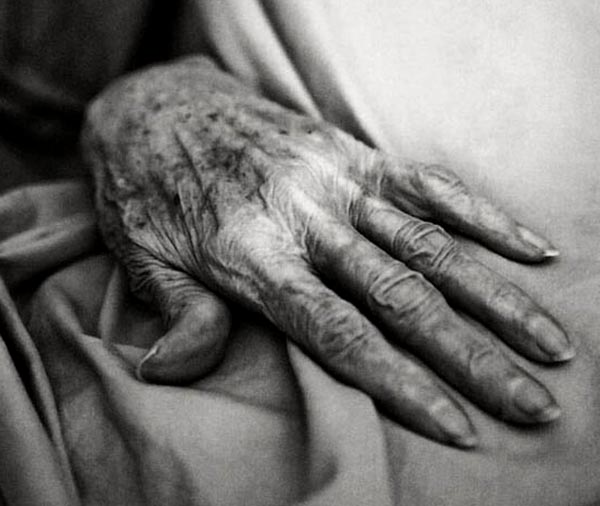
If you have any suggestions or if you want to interview someone
for the blog, contact Ross Taylor.